A method of beam focusing by two-electrode RF crossed
lenses with decelerating fields is proposed. The lenses are arranged
in accelerating gaps of a drift tube linac. The crossed lens is
a set of plane electrodes with rectangular apertures such that
the apertures in the neighbouring electrodes are rotated 90o
each other. Different variants of the focusing period structure
are considered. The bl
FD period is shown to be used for low energy part of the linac.
The transverse phase advance for the FD period is independent
on the particle phase when the synchronous harmonics of the accelerating
field is absent and the structure is analogous to RFQ with unmodulated
vanes in the case. In the main part of the linac it is worth to
change to the 2bl
FODO period to obtain essentially higher acceleration rate.
At present two basic methods of RF focusing of ions are used in linacs: the quadrupole focusing (with spatial-uniform and spatial-periodic structures) and alternating-phase focusing (APF) [1]. The spatial-uniform quadrupole (RFQ) focusing [2] and focusing in spatial-periodic systems of RF quadrupoles with "horned" electrodes [3] enable to obtain large phase length of radial stability region and high current limit. A common disadvantage of these methods is rather low acceleration rate. Besides a serious problem of maintenance of necessary electrical strength in accelerating system arises at realization of gaps with put forward electrodes ("horns"). The beam focusing in spatial-periodic system of RF rectangular aperture quadrupoles [4] and also alternating-phase focusing provide high acceleration rate, however, herewith a region of radial-stable phase capture is significantly reduced. The focusing strength in the structures decreases with enhancement of particle energy a fact that results in increase of transit time of the focusing period with a distance along the linac. Since an equality of instantaneous transverse frequencies at joints of periods with different transit time is difficultly satisfied, there is the growth of the effective emittance in the linac due to the beam mismatching with the channel.
Below a method of ion focusing in linac by decelerating
fields of RF crossed lenses [7] is considered which permits to
obtain phase length of radial stability region up to 360o
and energy-independent focusing strength, as well as high
values of current limit at low injection energy and acceleration
rate.
The considered method of beam focusing [7] is based on use of system of crossed lenses, to electrodes of which RF voltage is applied. Note, that the lenses with electrostatic fields are widely used in ion and electron optical systems [5]. The crossed lens is a set of plane electrodes with rectangular apertures such that the apertures in the neighbouring electrodes are rotated 90o each other (see Fig. 1).
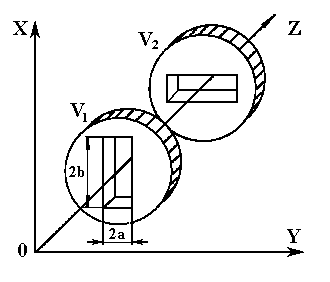
We choose a ratio of sides for the rectangular apertures from a condition a/b<<1 (see Fig. 1), then an electrical field component, directed along the slit, is negligible as compared with a component across the slit.
Within the considered method the two-electrode RF crossed lenses with decelerating fields are arranged in accelerating gaps of drift tubes linac. FODO structure of focusing period with arrangement of the crossed lenses through a gap of accelerating system, formed by drift tubes with round apertures, is shown in Fig. 2.
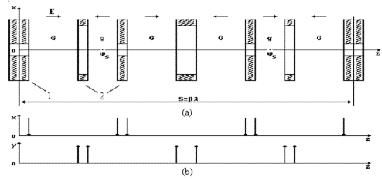
The lenses are identically aligned within the limits of the focusing half-period and rotated 90o in the subsequent one. The drift tubes and lenses are supplied in RF resonant system operating in p -mode.
A spatial distribution of focusing gradients in the FODO period is displayed in Fig. 2b. The radial particle motion is determined by transverse components of the accelerating fields and quadrupole fields of the crossed lenses. The accelerating field causes RF beam defocusing for autophasing (jsi < 0) mode. Owing to accepted orientation of the lenses and application to them appropriate RF voltage a particle moving along the axis undergoes action of the quadrupole fields with sign-alternating gradients (see Fig. 2b). It results in the effect of strong focusing in the channel.
Advantage of the method of beam focusing by the RF crossed lenses is opportunity in the best way to combine RF focusing and acceleration of the beam in the linac.
To see this we take the following into consideration. Firstly, use of the decelerating areas allows considerably to increase the focusing gradients, because directions of transverse field components inside the crossed lenses and between them coincide (see Fig. 2b). Secondly, since the quadrupole field gradients are not decreased with reduction of sizes of the decelerating areas, it is possible by choice of number of the crossed lenses in accelerating gaps to get energy-independent focusing strength and also expand the radial stability region. The expansion of radial stability region occurs due to increase of time of beam interaction with the quadrupole fields. Thirdly, decrease of acceleration rate caused by the decelerating areas is insignificant, since the ones are chosen rather narrow and arranged in that part of the accelerating gap, where energy gain of particle is small.
Advantage of the method of focusing by the RF crossed
lenses is also a fact, that the method is easily combined with
other ways of RF focusing, for example, focusing by the RF rectangular
aperture quadrupoles (see Fig. 3) or/and alternating-phase focusing
(jsi(z)
is a sign-alternating function in Fig. 2). In this case it is
possible to achieve reduction of number of the crossed lenses
and, consequently, increase of the acceleration rate, keeping
all advantages of the proposed method.
We consider a focusing by the RF crossed lenses in accelerating system with rectangular aperture drift tubes.
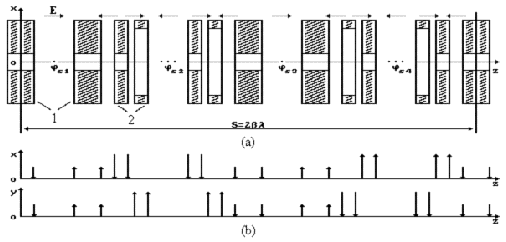
FD focusing period of length S=bl formed by two RF rectangular aperture drift tubes and pair of the crossed lenses is presented in Fig. 3. A feature of the given period is absence of spatial variation of focusing gradient sign along the structure axis (see Fig. 3). Obviously, that this property is kept for any number of the lens pairs. The strong focusing effect in this period, as well as in RFQ, is reached only by time variation of the field.
Let js (negative for autophasing mode) is the synchronous phase in centre of gap between the drift tubes, d is the thickness of drift tubes and electrodes of crossed lenses, G and g are the lengths of accelerating and decelerating gaps respectively (see Fig. 3). Then according to results of Ref. [6], the expression for transverse phase advance per period S at d/S<<1 has the form

where constant within the limits of period parameter po is defined by a relation
(2)
EG and Eg are the field amplitudes in accelerating and decelerating gaps; e and Wop are the charge and rest energy of proton; Z and A are the charge and mass numbers of ion; b and g are the average reduced velocity and energy of ion; l is the wavelength of accelerating field; kF=S/bl.
At G=g a synchronous harmonic of the field is absent and particles are not accelerated, then formula (1) is reduced to equality
(3)
As it follows from (3), the average transverse tune does not depend on a particle phase. Therefore it is possible to consider the FD period structure at EG=Eg and G=g as analogue of unmodulated RFQ channel. Decrease of field amplitudes in lenses (Eg < EG ) or reduction of lengths of decelerating gaps (g<G) results in effect of resonant particle acceleration and is equivalent to introduction of vane modulation in RFQ.
It is advantageous to use the FD periodic structure (see Fig. 3) as an initial part of the linac because this structure provides high current limit, due to large phase width of radial stability region and small length of the focusing period S=bl, and allows low injection energy, since the drift tubes and lens electrodes can be rather thin. The initial part of the RF crossed lens linac can be designed according to the procedure accepted for RFQ and contain 6D-matching, adiabatic bunching, and regular acceleration sections. In this case it is possible to get the linac parameters similar to the RFQ ones.
In the main part of the linac, where the bunches are already shaped and efficiency is the principal parameter of the accelerating system, it is worth to change to FODO period of length S=2bl (see Fig. 2) to obtain much higher acceleration rate as compared with the FD period (see Fig. 3).
We consider stability of proton motion in the FODO
focusing period (see Fig. 2) at the following parameters: the
field amplitudes in accelerating and decelerating gaps Eg
= EG =160 kV/cm, the transverse phase advance mt=60o,
and the synchronous phase in centre of gap between drift tubes
jsi=30o
(see Fig. 2). For the FODO period a dependence of the minimum
number of crossed lenses providing stable radial motion of particles
within the limits of separatrix on proton energy is presented
in Fig. 4a (curve 2). The appropriate acceleration rate for given
energy is shown in Fig. 4b (curve 2).
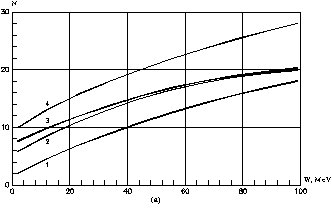
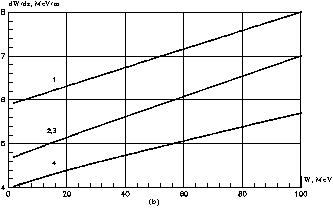
The FODO accelerating system is rather effective. In autophasing mode for FFDD structure [7] with the same parameters lenses are required almost 40% more than in the FODO system (cf. curves 4 and 2 in Fig. 4 ). Herewith distinction in the acceleration rate is about 20% (cf. curves 4 and 2 in Fig. 4b). The decrease of necessary number of crossed lenses in the FODO system is caused by the well known effect of lens focusing strengthening by a drift space.
Note, that the focusing properties of the FODO period weakly depend on a configuration of the drift tubes and are mainly determined by fields of the crossed lenses. Under other conditions being equal, for the FODO period with round aperture drift tubes the crossed lenses are required only 10% more than for the similar period with rectangular aperture ones (cf. curves 2 and 3 in Fig. 4 ). Besides manufacture of the round apertures in drift tubes is easier than the rectangular ones.
It is possible to reduce a number of the crossed
lenses in the focusing period and, consequently, to increase acceleration
rate in main part of the linac through decrease of RF defocusing
by change from autophasing to sign-alternating phasing. For the
FODO system with sign-alternating phasing mt=60o
and length of radial-phase stability region 90o are
reached at number of the lenses in the focusing period N=2-18
and the field in them 160 kV/cm in a wide energy range from 2
up to 100 MeV (see Fig. 4a, curve 1). Herewith the acceleration
rate is 6-8 MeV/m (see Fig. 4b, curve 1). By the last parameter
the considered system is on a par with the APF linac. For the
similar structure with autophasing N=6-20 crossed lenses are required,
a fact that results in decrease of the acceleration rate down
to 5-7 MeV/m (see Fig. 4a, curve 2).
[1] V.V.Kushin, "On increase of efficiency of an alternating-phase focusing in linacs", Atomic Energy, 1970, v.29, No 2, pp.123-124.
[2] I.M.Kapchinsky, V.A. Teplyakov, "Ion linac with a spatial-uniform strong focusing", Prib. i Tekhn. Eksp., 1970, No 2, pp.19-22.
[3] V.V.Vladimirsky, "Variant of a strong focusing in a linac", Prib. i Tekhn. Eksp., 1956, No 3, p.35.
[4] G.M.Anisimov, V.A. Teplyakov, "Focusing by an accelerating field"., Prib. i Tekhn. Eksp., 1963, No 1, pp.21-22.
[5] L.A.Baranova, S.Y.Javor, "Electrostatic electron lenses", Science, Moscow, 1986, pp.161-171.
[6] A.I.Balabin, S.B.Ugarov, "Floquet functions in focusing channel with an arbitrary structure of period", Preprint ITEP, Moscow, 1989, No 110.
[7] A.I.Balabin, G.N.Kropachev, V.V.Kushin, "Focusing of charged particle beams by RF crossed lenses", Preprint ITEP, Moscow, 1993, No 15.